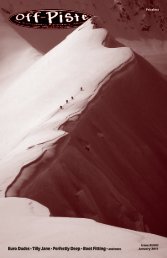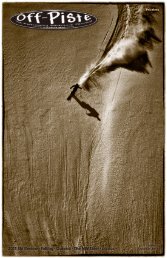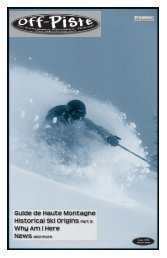Ski Review 03-04 The Fall Line Blisters 100 ... - Off-Piste Magazine
Ski Review 03-04 The Fall Line Blisters 100 ... - Off-Piste Magazine
Ski Review 03-04 The Fall Line Blisters 100 ... - Off-Piste Magazine
Create successful ePaper yourself
Turn your PDF publications into a flip-book with our unique Google optimized e-Paper software.
<strong>Blisters</strong> Revisited<br />
A Closer Look at Prevention and Treatment<br />
<strong>Blisters</strong> are equal<br />
opportunists. It does<br />
not matter what activity you<br />
pursue, if you are active in<br />
the outdoors, chances are<br />
you have, at some point,<br />
suffered the bane of<br />
blisters.<br />
You know the routine, an initial<br />
“hot spot” warns of their onset<br />
and far too often we simply<br />
ignore it. Eventually, there is the<br />
subsequent burning pain as<br />
fluid seeps between the skin<br />
layers and, finally, although<br />
often too late to stop it, the<br />
actual blister demands our<br />
attention.<br />
Some people seem prone to<br />
blisters and others immune.<br />
Most blisters occur on the feet<br />
and significant blisters can<br />
derail a trip. Day two on a hut<br />
trip that you have been<br />
planning for a full year is no<br />
by Paul Nicolazzo<br />
time to be derailed by an open<br />
oozing blister.<br />
Myths and methods abound for<br />
prevention and treatment alike.<br />
In order to separate myth from<br />
truth, we must first understand<br />
the forces that create blisters.<br />
MECHANISM OF INJURY<br />
Shear Forces<br />
Shear forces are exerted on our<br />
skin, socks, and footwear as we<br />
walk, run, ski, etc. When the<br />
force is strong enough to<br />
breakdown the surface<br />
resistance between two layers,<br />
movement results. With<br />
movement, comes friction and<br />
with friction comes heat (hence<br />
the term “hot spots”).<br />
Movement on the surface of the<br />
skin or between the skin’s<br />
layers is responsible for blister<br />
formation hence the importance<br />
of sock choice and footwear fit.<br />
Movement between multiple<br />
pair of socks or between the<br />
outer sock and the footwear<br />
rarely causes blisters.<br />
PREVENTION<br />
Conceptually, prevention is<br />
three-fold: 1) reduce general<br />
movement between layers in<br />
the footwear system,<br />
especially in or on the skin; 2)<br />
reduce friction and heat in, on,<br />
or near the skin; and, 3)<br />
deliberately create a “weak”<br />
shear layer as far from the skin<br />
as possible.<br />
Reduce general movement:<br />
• Choose well fitted footwear.<br />
Remember to size your boots<br />
with the socks you will be<br />
wearing<br />
• Choose good quality socks<br />
appropriate to the activity.<br />
• Make sure leather boots are<br />
well broken in.<br />
• Custom footbeds or liners in<br />
both ski and climbing boots go<br />
a long way in achieving a<br />
perfect fit.<br />
Reduce friction:<br />
• Keep your feet, socks, and<br />
boots clean; wash them on a<br />
regular basis.<br />
• Wear gaiters to help eliminate<br />
dirt, gravel, and snow from<br />
contaminating your system.<br />
• Keep your feet dry. Wet skin<br />
increases the surface<br />
adhesion while reducing the<br />
shear forces between the skin<br />
layers. Plastic shells and vapor<br />
barrier socks often exacerbate<br />
blister issues by trapping<br />
moisture next to the skin. Use<br />
synthetic socks next to your<br />
skin to wick excess moisture<br />
away from the surface and, if<br />
possible, air and dry your feet<br />
on a regular basis. If you have<br />
consistently moist skin (and<br />
blisters), you need to change<br />
your socks more frequently, air<br />
your feet out so that they<br />
remain dryer, or use less<br />
insulated footwear/socks.<br />
Deliberately create a<br />
weak shear layer<br />
• Wear a pair of liner socks and<br />
a pair of shock-absorbing<br />
socks.<br />
• Paint the affected areas with<br />
tincture of Benzoin and cover<br />
with cloth tape. Duct or pipe<br />
tape is okay if it the adhesive<br />
doesn’t irritate your skin. You<br />
will only know after you try it. I<br />
prefer cloth tape. CAUTION:<br />
Benzoin may cause skin<br />
irritation.<br />
• Use ShearBan on socks or<br />
footwear where there is a<br />
history of blister formation (it is<br />
not designed for direct skin<br />
application). ShearBan is a<br />
Teflon coated material originally<br />
designed for the prosthetics<br />
industry that reduces the shear<br />
forces between the socks or<br />
between the socks and<br />
footwear. I’ve field tested it for<br />
the past two years and found it<br />
to be amazing. Find out more<br />
about ShearBan at<br />
www.wildmedcenter.com<br />
TROUBLE SHOOTING<br />
• Are you giving your skin<br />
enough time to toughen under<br />
a new activity before pushing<br />
hard? If not, take it easier or<br />
add skin protection.<br />
• Is there a pattern to where the<br />
blisters appear (back of heals,<br />
instep, etc.)? If so, this is a<br />
potentially weak area and<br />
needs more time to toughen. Or<br />
you can try adding skin<br />
protection such as ShearBan.<br />
• Are the blisters related to a<br />
specific activity? If so, your<br />
boot/sock combination may not<br />
be as good as it could be.<br />
PREVENTION SUMMARY<br />
• Wear well-fitted and appropriate<br />
socks/footwear.<br />
• Keep feet/socks clean, cool,<br />
& dry.<br />
• Use a blister (liner) sock & a<br />
continued on page 22<br />
Issue Issue XVIII XVIII XVIII <strong>Off</strong>-<strong>Piste</strong> 15









